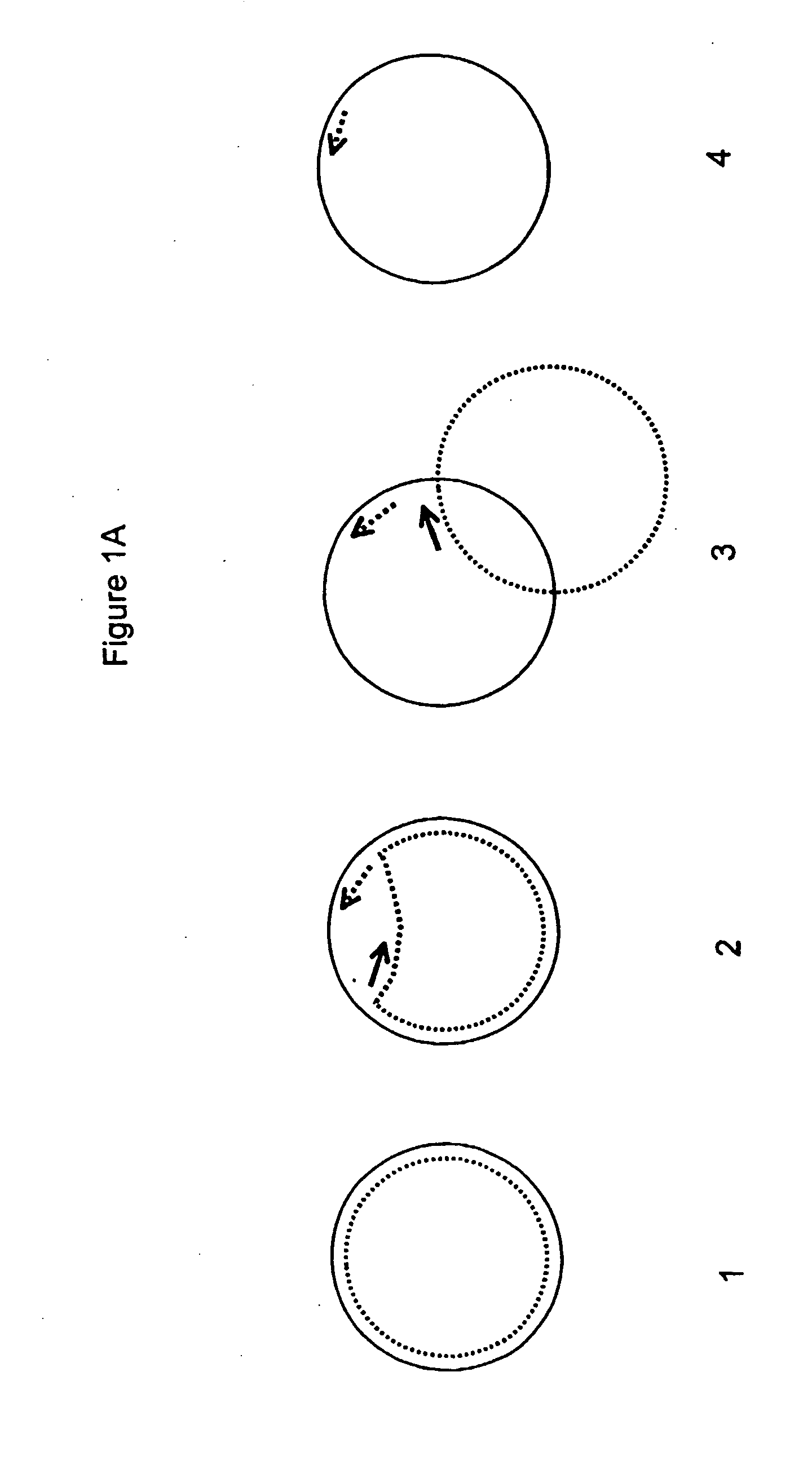Helicase-dependent amplification of circular nucleic acids
a technology of circular nucleic acids and helicases, which is applied in the field of amplifying circular nucleic acids, can solve the problems of restricting its portable use and difficult manipulation of the amplification produ
- Summary
- Abstract
- Description
- Claims
- Application Information
AI Technical Summary
Benefits of technology
Problems solved by technology
Method used
Image
Examples
example i
Amplification of Purified cDNA Molecules Using cHDA
[0113]Experiment A: Methods to Perform cHDA
[0114]A pCR2.1 (Invitrogen, Carlsbad, Calif.) derivative plasmid, pREP, containing the E. coli rep helicase (GenBank accession number U00096) was used as a target template. Oligonucleotides S1224 and S1233 (New England Biolabs, Inc., Beverly, Mass.) that anneal to regions flanking the rep insert were used as primers. A 50 μl reaction was set up by mixing 5 μl of 10× cHDA Buffer (350 mM tris-acetate, pH 7.5, 110 mM Mg-acetate, 50 mM DTT), 10 ng pREP, 20 pmole S1224, 20 pmole S1233, 50 nmole dNTP, 500 nmole dTTP, 200 ng T7 gp 4B protein, 6 μg T7 gp2.5 protein, and 1 unit of T7 Sequenase (USB, Cleveland, Ohio). The reaction was incubated at 25° C. overnight and 5 μl of the reaction product was analyzed by separation through a 1% agarose gel containing ethidium bromide (FIG. 2A). A DNA fragment of approximately 2.3 kb size was observed (FIG. 2A, lane 1) and is consisted with the predicted size ...
example iii
Optimization of cHDA Reaction Conditions
[0118]A. Determination of Specific Reagents Required for cHDA
[0119]A complete 50 μl reaction was set up as a control by mixing 5 μl of 10× cHDA Buffer (350 mM tris-acetate, pH 7.5, 110 mM Mg-acetate, 50 mM DTT), 10 ng pREP, 20 pmole S1224, 20 pmole S1233, 50 nmole dNTP, 500 nmole dTTP, 200 ng T7 gp 4B protein, 6 μg T7 gp2.5 protein, and 1 unit of T7 Sequenase (USB, Cleveland, Ohio). The requirement of each T7 protein was investigated. When one of the three T7 proteins was excluded from the reaction, no amplification product (FIG. 2A, lanes 2, 3, and 4) was observed and indicates that all three proteins are required for the cHDA reaction to proceed. Similarly, when both the helicase and SSB proteins were excluded, no amplification was detected (FIG. 2A, lane 5). Substitution of the T7 gp2.5 SSB protein with an equal amount of the T4 SSB did not support amplification (FIG. 2A, lane 6), indicating that a close coordination among the three T7 prot...
example iv
Characterization of cHDA Products
[0126]A. Restriction Enzyme Digestion of cHDA Products
[0127]Restriction enzyme digestions of the cHDA amplification products were performed to further verify that tandem repeats of the plasmid containing the target fragment were produced. The restriction enzymes Acc65I, SacI, and XhoI (New England Biolabs, Inc., Beverly, Mass.) have a unique site within the pREP plasmid (FIG. 4A). The product from a cHDA reaction performed using the pREP plasmid was used in a series of restriction enzyme digests. After performing cHDA reactions, Acc65I, SacI and / or XhoI was directly added to the reaction and incubated at 37° C. for 6 hours. Following enzymatic digestion, the reactions were separated by gel electrophoresis through a 1% agarose gel. Results from the digests indicated that the large molecular weight amplification products are the plasmid in tandem repeats, forming a concatemer (FIG. 4B).
[0128]B. Analysis of Higher Molecular Weight cHDA Products
[0129]To ...
PUM
| Property | Measurement | Unit |
|---|---|---|
| Temperature | aaaaa | aaaaa |
| Size | aaaaa | aaaaa |
Abstract
Description
Claims
Application Information
 Login to View More
Login to View More - R&D
- Intellectual Property
- Life Sciences
- Materials
- Tech Scout
- Unparalleled Data Quality
- Higher Quality Content
- 60% Fewer Hallucinations
Browse by: Latest US Patents, China's latest patents, Technical Efficacy Thesaurus, Application Domain, Technology Topic, Popular Technical Reports.
© 2025 PatSnap. All rights reserved.Legal|Privacy policy|Modern Slavery Act Transparency Statement|Sitemap|About US| Contact US: help@patsnap.com



